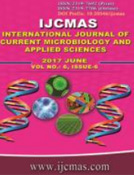


 National Academy of Agricultural Sciences (NAAS)
National Academy of Agricultural Sciences (NAAS)

|
PRINT ISSN : 2319-7692
Online ISSN : 2319-7706 Issues : 12 per year Publisher : Excellent Publishers Email : editorijcmas@gmail.com / submit@ijcmas.com Editor-in-chief: Dr.M.Prakash Index Copernicus ICV 2018: 95.39 NAAS RATING 2020: 5.38 |
Experiment on anther culture in sweet pepper (Capsicum annuum L.) hybrids Bharat and Indra was carried out to investigate the responses of three anther developmental stages on the production of androgenic/microspore derived calli, using MS medium supplemented with various growth regulators in different ratios and with or without pre-culture heat treatment of anthers at 35oC for seven days. In general, heat treated anthers resulted in increased callus induction percentage in all growth regulator combinations and flower bud developmental stages. Most promising results were obtained on MS medium supplemented with 1.0 mg/l zeatin along with 0.2 mg/l 2, 4-D and 15.0 mg/l AgNO3 with heat treatment reported maximum callus induction in both the hybrids, 54.02% and 60.92%, respectively when the anthers were at developmental stage-II (i.e. microspores at late uni-nucleate stage). Irrespective of anther developmental stage, zeatin was found superior in callus induction from cultured anthers followed by TDZ and Kinetin. Response of BAP was noted poor as compared to other cytokinins tested. The anther containing microspore at late uni-nucleate stage i.e. stage-II recorded maximum callus induction followed by anthers at stage-I having microspore at early uni-nucleate stage. The anthers at developmental stage-III, which contained mature pollen grains, were poor in callus production. Supplementation of MS medium with AgNO3 15.0 mg/l along with other growth regulators gave better results in all the stages of anther development.
 |
 |
 |
 |
 |